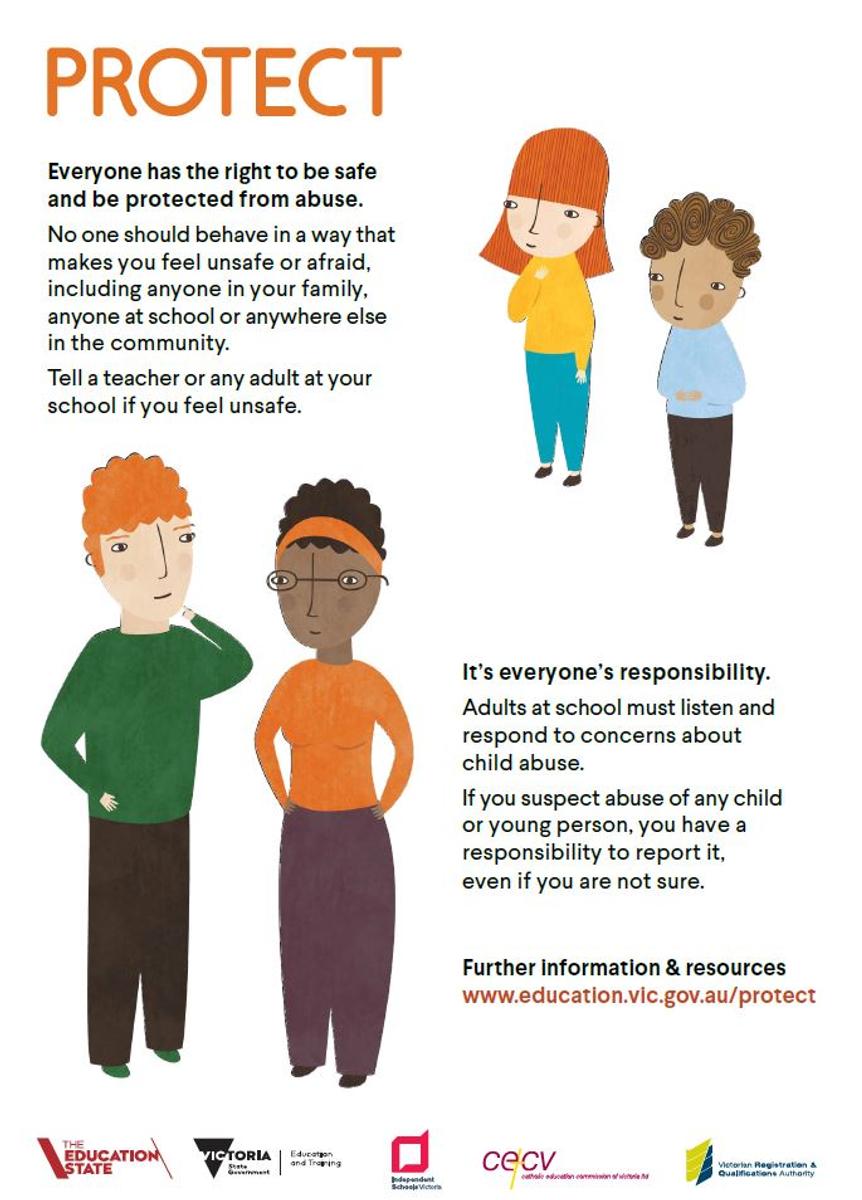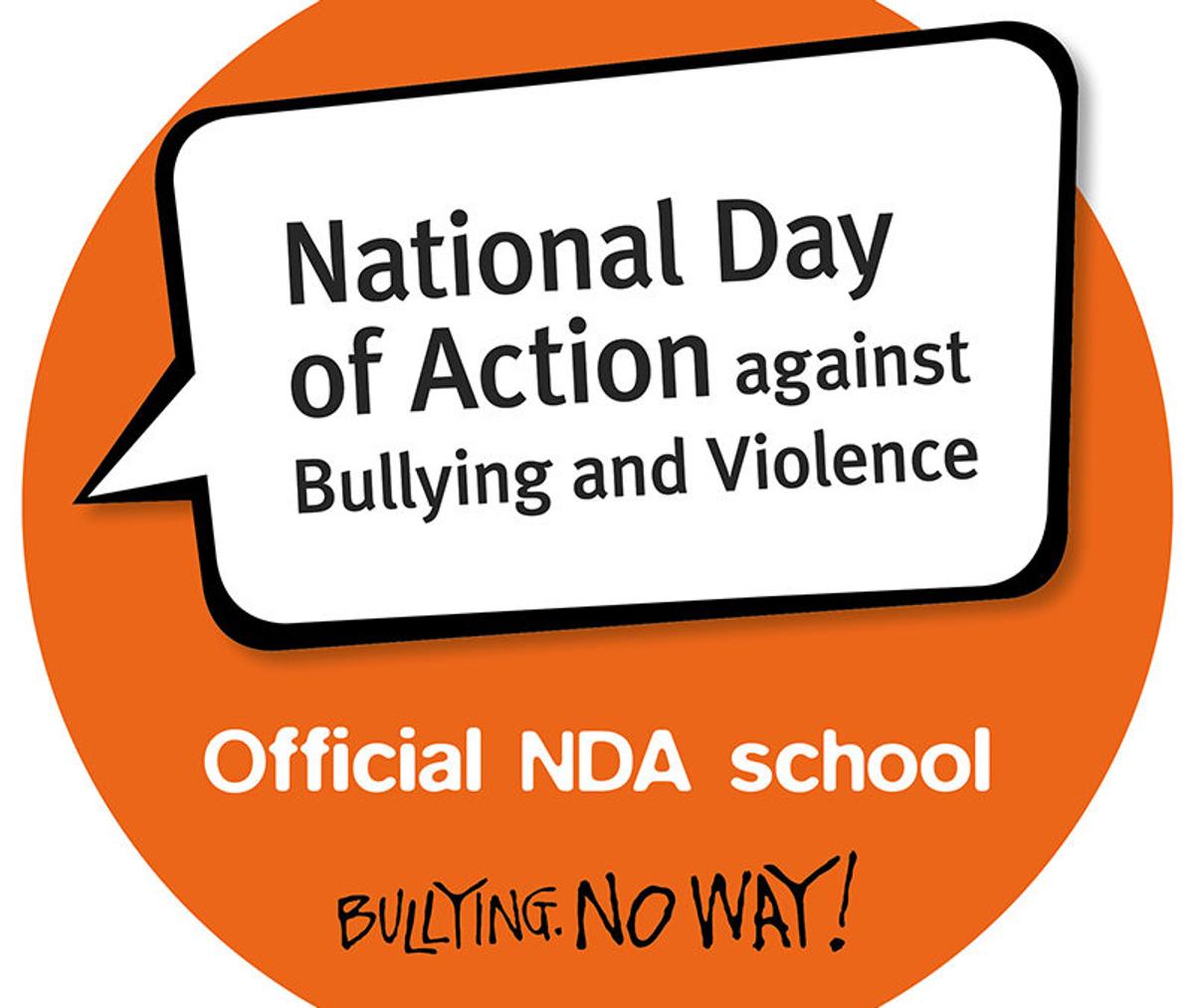Wellbeing @ BRPS

BRPS Wellbeing Curriculum
As part of our Respectful Relationships program and our commitment to implementing the Child Safe Standards, each class will be learning about their bodies and how to keep them safe. Self-care and help-seeking strategies empower children to assert their rights over their own bodies and to gain the support they need if someone is breaching their rights. One of the help-seeking strategies students will be learning about is the ‘NO, GO, TELL’ model. This model includes:
Say NO or make it clear you do not like what is happening.
GO – get away from the situation.
TELL a trusted adult about what has happened.
You may wish to support your child with this learning by engaging in conversations at home. For further information, please follow the link below.
Child Safe Standards
https://www2.education.vic.gov.au/pal/child-safe-standards/policy
Respectful Relationships
https://www.vic.gov.au/respectful-relationships
National Day of Action against Bullying and Violence
Whole school focus during 4th - 8th September
The National Day of Action against Bullying and Violence is celebrated annually on the third Friday in August. This year it will be held on 18th August. Due to our concert preparations, our school will be participating in activities to support this day during Week 9, from the 4th - 8th of September.
The NDA theme for 2023 is 'growing connections'. This theme supports research findings that strong school community connections and social skills are protective factors in the prevention of bullying and help enable positive, help-seeking behaviours in students.
These links provide resources for students and families:
Growing positive connections with other students and the broader school community can enhance students' cognitive, behavioural and emotional engagement. Our students will be engaging in activities to highlight the importance of connections in preventing bullying, and help students identify the connections they have in their lives.
The following article was sent to us by the Cyber Safety Project.
Cyber Bullying, Could my child be a victim?
It is frustrating to think that bullying continues to be a problem amongst young people today. Being teased and bullied online can be particularly hurtful to a child, who may feel as if there is no escape from the relentless ridicule. While we all know bullying exists, do you know how to tell if your child is a target of cyber bullying?
Statistics show that 1 in 5 young people under the age of 18 have reported experiencing online bullying. Most children that experience bullying online are afraid or hesitant to tell anybody about their experience as a result of the fear that has been created, such as deflated sense of self-worth or embarrassment, lack of confidence or not believing that those around them can relate to how they are feeling.
What should I be looking out for?
The signs of online bullying are often similar to that of offline bullying. Like offline bullying, cyber bullying is defined as ongoing and deliberate hurtful or aggressive behaviour that occurs during time spent online. There is no exactness as to how a child may react if they are being cyber bullied. However, for a child experiencing cyber bullying, there are some signs you may start to observe, particularly when they are using their connected technology. You may see a child demonstrate any one (or more) of the following behaviours:
- Frequent anger and outbursts, mood swings, anxiety and tears during or just after technology use
- Spending less time (or more time) on their devices than they usually do
- Appearing edgy when devices need to be switched off or put away
- An unwillingness to discuss their online communication
- Reduced interactions with peers and friends through offline contexts
- Asking you to block comments or phone numbers
- Restricting your view of their screen when they are using communication apps or social networks
I think my child may be experiencing bullying online, what can I do?
If you are concerned that your child may be experiencing online bullying here are some suggested intervention strategies:
1. Start by talking
While getting all the details may seem like a good idea, your child may not feel entirely comfortable disclosing everything to you. In fact, your questions may feel like an interrogation. Instead, start by talking about your own online experiences, weaving in the good and the bad. It may seem strange or ‘out of the blue’ to hear you talking about technology in this way, so the earlier these conversations begin in your household, the more normalised conversations about this topic will become. It’s also a good idea to regularly remind your children that ‘There is nothing you could ever do that I wouldn’t forgive’, ‘We all make mistakes and I am here to help you make things right’, and ‘No matter what happens, I am always here to help’. Looking for some conversation starter ideas around this topic? We’ve put together a list for you here.
2. Discuss help seeking strategies
Whilst we would all hope our children come to us as the first point of call, for many children the thought of telling a parent is ‘out of the question’ for fear of technology being banned or getting into trouble. Help your child identify three trusted adults (other than you) in their life that they could turn to for help when things are going wrong or they aren’t sure what to do. This may be a grandparent, sibling, cousin, aunt or uncle, or a teacher at school. Also ensure your children know how to access the Kids Help Line.
3. Document and report misconduct
Should you find material online that you believe is inappropriate conduct and involves your child, take a screenshot of the activity as evidence. There are laws about cyber bullying that you and your children should be aware of. Resist the urge to close down accounts or respond yourself. When reporting serious cases of bullying, the police will require access to social media accounts as well as evidence. If you aren’t sure if you should report cyber bullying, check out this resource from the eSafety Commissioner.
Social Networking applications are taking greater responsibility for cyber bullying and inappropriate content appearing on their platforms. Most Social Networking applications have a reporting system in place aimed at flagging inappropriate content and abusive behaviour. Talk about these features and ensure your children know how to use them and the fact that when using these features they remain anonymous.
4. Limit online access
If you start to see behavioural shifts around the time your child is using connected technology (such as anger, anxiety or signs of depression) you may want to limit their access. Set clear rules and expectations that promote appropriate screen time use, including help seeking strategies when problems or uncomfortable situations arise. Our Family Digital Use Guidelines are a perfect starting point for setting technology use expectations for the whole family. Many applications have great parental controls that can be helpful in monitoring your child’s digital use, including the use of screen time analytics through Apple Family Sharing or Google Family Link.
5. Foster positive online protocols
One of the best ways to prevent cyber bullying is to make sure your children clearly understand what cyber bullying is and how to identify it. They must know that bullying is not tolerated in either offline or online spaces. Make sure they understand that they too must respect others online, reducing the likelihood of them becoming a target when they are conducting kind, friendly and respectful dialogue themselves. Another important step is to ensure your children make use of Privacy Settings within their apps or accounts. There are often settings that allow you to block specific users or turning on features such as ‘hide offensive comments‘.
6. Promote kindness and positivity in these spaces
Online communities, whether that be within online games or social networks, are regulated by those who participate: your children. They are the creators of their online communities and set the tone for the environments in which they engage. Through gaming and social media we are regularly hearing of toxic, inappropriate and harmful dialogue. It’s important that young people are calling out, blocking and reporting behaviour that they don’t feel aligns with their own values or the terms and conditions set out by the digital platform. Help your child to promote and encourage kind behaviour towards their friends and make healthy choices when it comes to who they choose to engage with in online spaces.
7. Get your child actively engaged offline
Help your child discover and establish positive friendships in offline settings such as engaging with sports, hobbies or extra curricular activities. Through a child’s formative years, these face to face relationships offer positive offline experiences for children and allow for the development of authentic and life long friendships to flourish. Having offline friends can create an important support network and provide your children with someone to turn to when things go wrong for them online.
Preventing cyber bullying may feel like an impossible feat, but taking small actions, advocating, and building awareness are our frontline defence against this social phenomenon. Understanding and talking about online bullying must become a normalised conversation in every household.
If bullying has occurred, parents must be careful not to react with anger or take action without consulting their child. Young people often hide bullying from their parents because they fear a parent will make things worse.
At school or at home we can promote positive values and teach our children the actions they can take to become UPSTANDERS in both online and offline settings. An Online Upstander is someone who is willing to take action to support a person being targeted by cyber bullying by standing up for them, telling a teacher or other adult, reporting inappropriate conduct or simply reaching out to a victim to ask if they are okay. Let’s continue to create a movement of Online Upstanders and create the positive online communities that we want!
NEED HELP WITH CYBERBULLYING? REPORT ABUSE HERE.
Davina Dibbs
WELLBEING LEADER


